Metabarriers for mitigating traffic-induced surface waves: Mechanism dependence on buried arrangements
IF 3.4
3区 工程技术
Q1 MECHANICS
International Journal of Solids and Structures
Pub Date : 2024-10-28
DOI:10.1016/j.ijsolstr.2024.113120
引用次数: 0
Abstract
Locally resonant metamaterials provide exceptional wave manipulation capabilities in the low-frequency regime. This study introduces a buried metabarrier, which can simultaneously harness both resonant and geometric scatterings, to attenuate surface Rayleigh waves at both low and high frequencies induced by traffic. In particular, how the buried arrangements of metabarriers influence their resonant- and geometric-scattering mechanisms is investigated by considering the metabarrier units buried vertically and horizontally in the ground. To this purpose, a numerical finite element model, which is verified through comparisons with existing studies, is developed to analyze the attenuation performance of the metabarrier. Using this model, we perform parametric studies to examine the effects of the material properties and dimensions of the metabarriers on their attenuation behavior. Due to resonant scattering, low-frequency Rayleigh waves are mainly reflected by the vertical metabarriers; in contrast, they are predominantly converted into refracted bulk waves by the horizontal metabarriers. Additionally, the geometric scattering of horizontal metabarriers yields Bragg effects, which can reflect more high-frequency Rayleigh waves and induce a partial mode conversion to transverse bulk waves. Our systematic investigations will, to some extent, facilitate the future design of a well-performing metabarrier attenuating broadband Rayleigh waves.
用于减缓交通引起的表面波的元载体:机制取决于埋设方式
局部谐振超材料在低频领域具有卓越的波操纵能力。本研究介绍了一种埋入式超材料,它可以同时利用谐振和几何散射来衰减交通诱发的低频和高频表面瑞利波。特别是,通过考虑垂直和水平埋入地下的元屏障单元,研究了元屏障的埋入布置如何影响其共振和几何散射机制。为此,我们开发了一个有限元数值模型来分析元屏障的衰减性能,并通过与现有研究的比较进行了验证。利用该模型,我们进行了参数研究,以检验元壁垒的材料特性和尺寸对其衰减行为的影响。由于共振散射,低频瑞利波主要被垂直元屏障反射;相反,它们主要被水平元屏障转化为折射体波。此外,水平元载波的几何散射会产生布拉格效应,从而反射更多的高频瑞利波,并诱导部分模式转换为横向体波。我们的系统研究将在一定程度上促进未来设计性能良好的元载波,以衰减宽带瑞利波。
本文章由计算机程序翻译,如有差异,请以英文原文为准。
求助全文
约1分钟内获得全文
求助全文
来源期刊
CiteScore
6.70
自引率
8.30%
发文量
405
审稿时长
70 days
期刊介绍:
The International Journal of Solids and Structures has as its objective the publication and dissemination of original research in Mechanics of Solids and Structures as a field of Applied Science and Engineering. It fosters thus the exchange of ideas among workers in different parts of the world and also among workers who emphasize different aspects of the foundations and applications of the field.
Standing as it does at the cross-roads of Materials Science, Life Sciences, Mathematics, Physics and Engineering Design, the Mechanics of Solids and Structures is experiencing considerable growth as a result of recent technological advances. The Journal, by providing an international medium of communication, is encouraging this growth and is encompassing all aspects of the field from the more classical problems of structural analysis to mechanics of solids continually interacting with other media and including fracture, flow, wave propagation, heat transfer, thermal effects in solids, optimum design methods, model analysis, structural topology and numerical techniques. Interest extends to both inorganic and organic solids and structures.

 求助内容:
求助内容: 应助结果提醒方式:
应助结果提醒方式:


